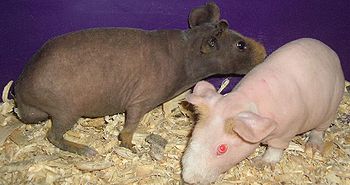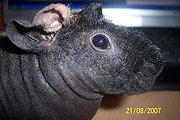
Skinny pig
Encyclopedia

Hairless
Hairless, also known as H, is a well-characterized Drosophila gene. Many mutations to hairless are embryonic lethal; however, there are several viable hairless mutants....
breed of Guinea pig
Guinea pig
The guinea pig , also called the cavy, is a species of rodent belonging to the family Caviidae and the genus Cavia. Despite their common name, these animals are not in the pig family, nor are they from Guinea...
. Skinny pigs typically have hair on their muzzles, feet and legs, but are hairless over the remainder of their bodies. Some have a thin covering of fuzzy hair on their backs as well. A healthy Skinny has skin that is mostly smooth with some wrinkling around the legs and neck, the body is full with no appearance of spine or ribs. Skinnies can come in a variety of colours and patterns, such as Dutch, Tortoiseshell, Himalayan and many others. "Skinny" is not a synonym for all hairless guinea pigs, but refers to this specific breed.
The modern Skinny pig breed originated with a cross between haired guinea pigs and a hairless lab strain. The hairless strain that it is most likely related to was a spontaneous genetic mutation that was first identified at Montreal's Institute Armand Frappier in 1978, in a colony of Hartley lab guinea pigs. In 1982 they were sent to Charles River Laboratories to be bred for laboratory use and are commonly used in dermatology studies today. They are an outbred strain that has an intact thymus
Thymus
The thymus is a specialized organ of the immune system. The thymus produces and "educates" T-lymphocytes , which are critical cells of the adaptive immune system....
and normal immune system.
Unique traits

Their sensitive skin has very much the same appearance as human skin, but has the same needs as normal guinea pig skin. Exposed skin is vulnerable to injuries and fungal infections unless precautions are taken. Skinnies are housed indoors and they are usually kept with nesting materials such as a blanket or cloth bag for heat conservation. The breeding protocol for Skinnies requires out crossing to haired carriers at least every other generation. This is an important step in the breeding process, which makes them a poor choice for novice breeders. Skinnies are born nearly hairless and develop more hair as they mature, they can have varying degrees of hairlessness at different life stages. Haired Skinny carriers remain haired their entire life but carry the hairless gene. Even though the Skinny is a relatively new breed among pet owners and cavy fanciers, it is gaining popularity in Canada, Europe, Scandinavia and Russia as well as in the United States where it was introduced in the late 1990s.

